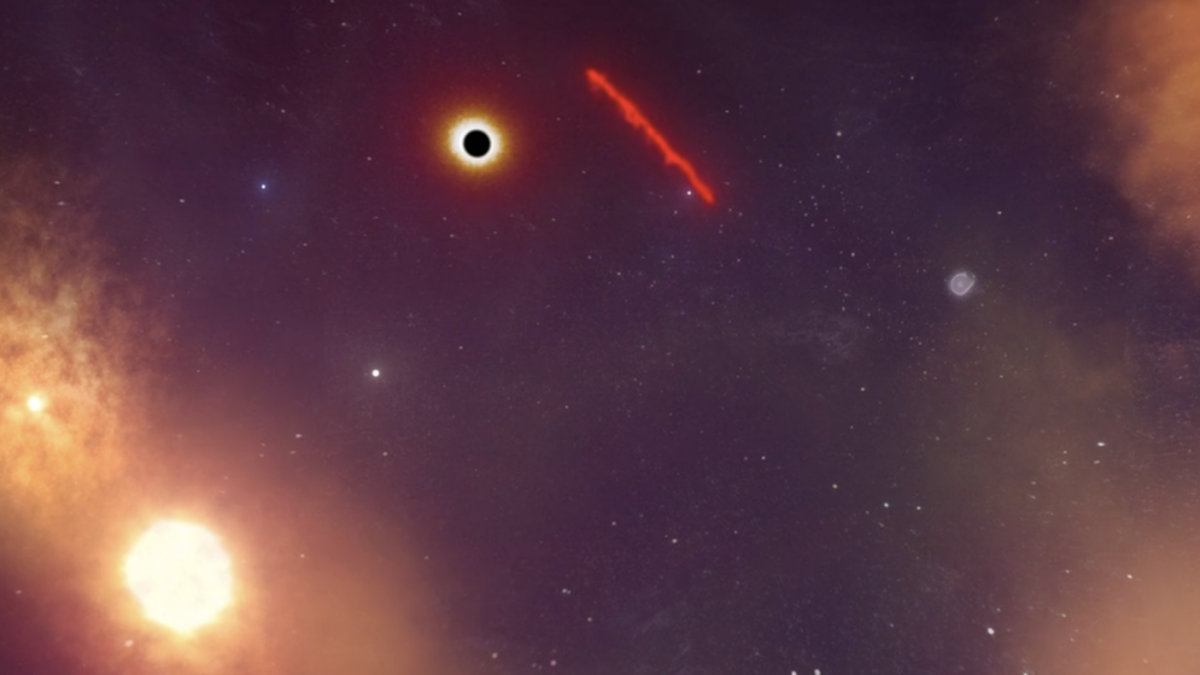Entertainment
Scientists watch as a black hole destroys doomed object in our galaxy

Right now, in the center of our galaxy, an enormous black hole is stretching an object apart like it were taffy.
And scientists currently have a rare view, and images, of this extreme cosmic event playing out.
A thick cloud of gas and dust dubbed “X7” is rapidly approaching the supermassive black hole Sagittarius A*. Black holes harbor almost unimaginable gravity due to their extremely concentrated mass (if Earth were crushed into a black hole, it would be under an inch across), and astronomers have now watched X7 changing for two decades as it veers closer to its last years. The latest observations, published in The Astrophysical Journal(Opens in a new tab), reveal that X7 has been stretched trillions of miles. It’s now 3,000 astronomical units in length. An astronomical unit is 93 million miles, or the distance between the sun and Earth.
X7 doesn’t have much time left. The black hole’s gravitational power is relentless.
“In the near future, it will pull X7 apart,” Anna Ciurlo, an astrophysicist at the University of California, Los Angeles, and the lead author of the research, told Mashable. “We’re lucky to observe it now.”
X7’s immense stretching demonstrates the cosmic influence of a black hole. The leading edge of the cloud is subject to more gravitational tugging than the tail, resulting in the long stretch. By 2036, X7 will swing to its closest point around Sagittarius A*, and soon after, dissolve. Then, the remnants will spiral around the black hole, heating up and releasing energy into space. Some of this matter will inevitably fall into the black hole, never to escape. (Once an object passes a boundary on a black hole called the “event horizon,” there’s no way for anything to conceivably escape — that would mean moving faster than the speed of light.)
“In the near, future it will pull X7 apart.”
In the first graphic below, you can see X7 being progressively stretched between 2002 and 2021. Astronomers made the observations using the W. M. Keck Observatory atop Hawaii’s towering Mauna Kea, which is home to two of the largest telescopes in the world, at 10 meters, or nearly 33 feet, across.
Below this graphic is an animation illustrating how X7 is being pulled apart and then destroyed as it approaches the supermassive black hole.

The object X7 progressively stretched by the supermassive black hole at the center of our galaxy, Sagittarius A*.
Credit: A. Ciurlo et al. / UCLA GCOI / W. M. Keck Observatory
Tweet may have been deleted
(opens in a new tab)
(Opens in a new tab)
Peering into the center of the galaxy
It’s enormously difficult to observe an object like X7 traversing the center of our galaxy. The galactic center is packed with stars, gas, and dust, which obscures much activity. Yet Ciurlo and her team have been able to track X7 for four reasons:
-
The telescope’s size: A larger telescope means finer resolution and more detail, especially in objects many light-years away. The W. M. Keck Observatory(Opens in a new tab), as noted above, is home to two of the largest telescopes on Earth.
-
Infrared viewing: The type of light we can see, called visible light, is difficult to see at the galaxy’s center. “When we observe the galactic center, we are looking through a lot of dust,” Ciurlo explained. “It obscures visible light.” For this reason, the astronomers used instruments that view a type of light that we can’t see, called infrared light, which travels in longer wavelengths than visible light and slips through dense clouds of dust and gas.
-
Adaptive optics: The Keck telescopes use a powerful technology, called adaptive optics(Opens in a new tab), which removes distortions that inevitably occur when looking through Earth’s turbulent atmosphere.
-
Repeated observations: Diligently observing the galactic center allowed astronomers to track the changes and details in X7 as it travels closer to the black hole.

In this image of the Milky Way’s galactic center, the reddish orange masses are gas and dust clouds; the magenta circles and dots are stars; and X7 is the elongated red object.
Credit: A. Ciurlo et al. / UCLA GCOI / W. M. Keck Observatory
Where did X7 come from?
A looming question is where X7, a cloud of gas and dust, originated. The researchers have two ideas:
-
It’s possible X7 could have broken off from a larger gaseous structure, and its trajectory sent it toward Sagittarius A*.
-
Alternatively, X7 could have been ejected into space during a close encounter between two stars. The stars could have made a near pass, or even merged. When this happens, gas is ejected into space, which could have formed X7. (Unlike the sun, most stars exist in pairs with another star relatively nearby.)
Astronomers like Ciurlo will continue watching X7 as it traverses the galactic center and enters its final cosmic years. It’s an extraordinary opportunity to view a violent event unfolding in deep space, near our galaxy’s supermassive black hole.
“It’s a lot of fun to see in real time,” Ciurlo marveled.
-

 Entertainment6 days ago
Entertainment6 days ago‘The Brutalist’ AI backlash, explained
-

 Entertainment6 days ago
Entertainment6 days agoOnePlus 13 review: A great option if you’re sick of the usual flagships
-

 Entertainment5 days ago
Entertainment5 days agoWhat drives John Cena? The ‘What Drives You’ host speaks out
-

 Entertainment4 days ago
Entertainment4 days ago10 Sundance films you should know about now
-

 Entertainment4 days ago
Entertainment4 days agoEvery Samsung Galaxy Unpacked announcement, including S25 phones
-

 Entertainment3 days ago
Entertainment3 days agoA meteorite fell at their doorstep. The doorbell camera caught it all.
-

 Entertainment3 days ago
Entertainment3 days ago‘Assassin’s Creed Shadows’ has a little something for everybody
-

 Entertainment2 days ago
Entertainment2 days agoWhat are immigration red cards? How the internet is rallying behind undocumented workers


















